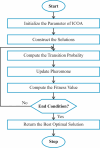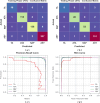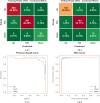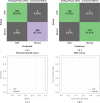Leveraging fuzzy embedded wavelet neural network with multi-criteria decision-making approach for coronary artery disease prediction using biomedical data
- PMID: 39730749
- PMCID: PMC11681245
- DOI: 10.1038/s41598-024-82019-0
Leveraging fuzzy embedded wavelet neural network with multi-criteria decision-making approach for coronary artery disease prediction using biomedical data
Abstract
Coronary artery disease (CAD) is the main cause of death. It is a complex heart disease that is linked with many risk factors and a variety of symptoms. In the past few years, CAD has experienced a remarkable growth. Prompt risk prediction of CAD would be capable of decreasing the death rate by permitting timely and targeted treatments. Angiography is the most precise CAD diagnosis technique; however, it has several side effects and is expensive. Multi-criteria decision-making approaches can well perceive CAD by analysing main clinical indicators like ChestPain type, ST_Slope, and HeartDisease presence. By assessing and evaluating these factors, the model improves diagnostic accuracy and aids informed clinical decisions for quick CAD detection. Mainly machine learning (ML) and deep learning (DL) use plentiful models and algorithms, which are commonly employed and very useful in exactly detecting the CAD within a short time. Current studies have employed numerous features in gathering data from patients while using dissimilar ML and DL models to attain results with high accuracy and lesser side effects and costs. This study presents a Leveraging Fuzzy Wavelet Neural Network with Decision Making Approach for Coronary Artery Disease Prediction (LFWNNDMA-CADP) technique. The presented LFWNNDMA-CADP technique focuses on the multi-criteria decision-making model for predicting CAD using biomedical data. In the LFWNNDMA-CADP method, the data pre-processing stage utilizes Z-score normalization to convert an input data into a uniform format. Furthermore, the improved ant colony optimization (IACO) method is used for electing an optimum sub-set of features. Furthermore, the classification of CAD is accomplished by utilizing the fuzzy wavelet neural network (FWNN) technique. Finally, the hyperparameter tuning of the FWNN model is accomplished by employing the hybrid crayfish optimization algorithm with the self-adaptive differential evolution (COASaDE) technique. The simulation outcomes of the LFWNNDMA-CADP approach are investigated under a benchmark database. The experimental validation of the LFWNNDMA-CADP approach portrayed a superior accuracy value of 99.49% over existing techniques.
Keywords: Biomedical Data; Coronary artery disease; Feature selection; Fuzzy wavelet neural network; Hyperparameter tuning; Multi-criteria decision making.
© 2024. The Author(s).
Conflict of interest statement
Declarations. Competing interests: The authors declare no competing interests.
Figures














Similar articles
-
Deep convolutional fuzzy neural networks with stork optimization on chronic cardiovascular disease monitoring for pervasive healthcare services.Sci Rep. 2025 May 30;15(1):19008. doi: 10.1038/s41598-025-02924-w. Sci Rep. 2025. PMID: 40447750 Free PMC article.
-
Development of an efficient novel method for coronary artery disease prediction using machine learning and deep learning techniques.Technol Health Care. 2024;32(6):4545-4569. doi: 10.3233/THC-240740. Technol Health Care. 2024. PMID: 39031414 Free PMC article.
-
Utilizing hybrid functional fuzzy wavelet neural networks with a teaching learning-based optimization algorithm for medical disease diagnosis.Comput Biol Med. 2019 Sep;112:103348. doi: 10.1016/j.compbiomed.2019.103348. Epub 2019 Jul 7. Comput Biol Med. 2019. PMID: 31356992
-
Machine Learning Approaches for Detecting Coronary Artery Disease Using Angiography Imaging: A Scoping Review.Stud Health Technol Inform. 2023 Jun 29;305:244-248. doi: 10.3233/SHTI230474. Stud Health Technol Inform. 2023. PMID: 37387008
-
Deep learning techniques for automated coronary artery segmentation and coronary artery disease detection: A systematic review of the last decade (2013-2024).Comput Methods Programs Biomed. 2025 Aug;268:108858. doi: 10.1016/j.cmpb.2025.108858. Epub 2025 May 15. Comput Methods Programs Biomed. 2025. PMID: 40408829 Review.
References
-
- Wang, P., Lin, Z., Yan, X., Chen, Z. & Ding, M. Y. S., & Meng, L. Awear able ECG monitor for deep learning based real-time cardiovascular disease detection. (2022).
-
- Bakar, W. A. W. A., Josdi, N. L. N. B., Man, M. B. & Zuhairi, M. A. B. A review: Heart disease prediction in machine learning & deep learning. In: Proc. 19th IEEE Int. Colloq. Signal Process. Appl. (CSPA). 150–155 (2023).
-
- Kim, C. et al. ‘A deep learning–based automatic anal ysis of cardiovascular borders on chest radiographs of valvular heart disease: Development/external validation. Eur. Radiol.32 (3), 1558–1569 (2022). - PubMed
-
- Malnajjar, M., Khaleel, Abu-Naser & Samy, S. Heart sounds analysis and classification for cardiovascular diseases diagnosis using deep learning. http://dspace.alazhar.edu.ps/xmlui/handle/123456789/3534 (2022).
-
- Qureshi, M. A., Qureshi, K. N., Jeon, G. & Piccialli, F. Deep learning based ambient assisted living for self-management of cardiovascular conditions. Neural Comput. Appl. 34 (13), 10449–10467 (2022).
MeSH terms
LinkOut - more resources
Full Text Sources
Medical
Miscellaneous

